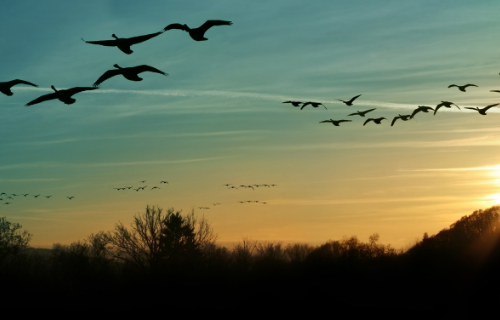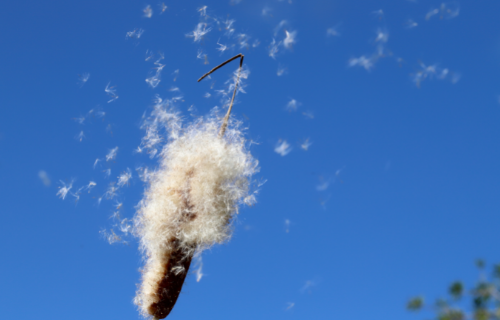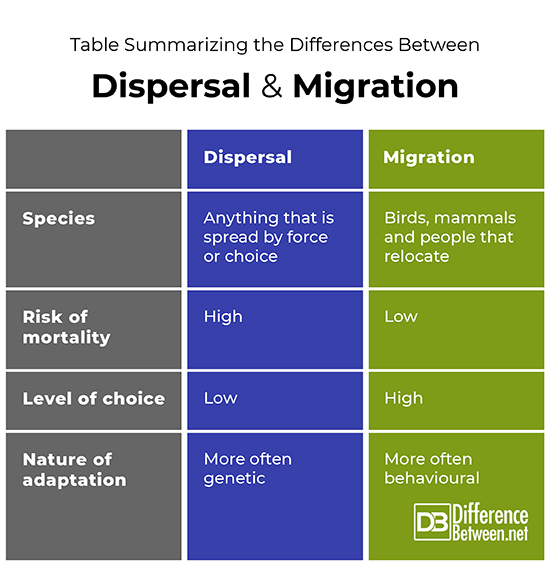Difference Between Dispersal and Migration

Dispersal means the process or action of spreading or distributing people, creatures, plants, or things over a wide area, implying that the people, creatures, or things move off in different directions (Oxford Languages). For example, one might disperse a collection of books by sending some to a library, others to a secondhand bookshop, and still others to friends who might find specific books interesting.
Migration is a type of dispersal that implies the seasonal movement of creatures from one region to another, for example, swallows migrate to warmer regions on an annual basis, and the movement of people some distance from their usual place of residence for work, for example, migrant mineworkers in South Africa who return home as well those crossing the Mexican border in search of the American Dream or Africans crossing the Mediterranean Sea in order to access Europe on a more permanent basis. Things and plants cannot migrate because migration implies the ability to shift one’s location independent of other elements, like the wind dispersing seeds or people spreading ideas.

Types of migration and dispersal
Dispersal is differentiated into two types: Natal dispersal implies the movement and then breeding away from the area of origin, whereas breeding dispersal is movement to another location after the seeding or breeding season. Dispersal in plants is natal dispersion, and in mammals, breeding dispersal is commonly sex-biased in so much as females tend to disperse more often than males, although the opposite is true for birds (A.P. Ramakrishnan).
Migration assumes dispersal, and a number of different types of migration exist, for example, people may migrate through conquest, invasion, and colonization; choose to leave their country of origin for economic or educations purposes. Among animals, patterns of migration among species vary widely (Heather E. Watts). Many species make predictable migrations between the same locations each year, which is described as obligate migration (I. Newton). Less predictable migrations are termed facultative migrations, one form of which is nomadic migrations where birds rarely return to the same location and the timing of their migration differs from year to year and/or may not happen some years. Fugitive migrations are caused by severe or unpredictable disruptions in a local environment, and the birds return once the disruption is over (Heather E. Watts).
Migration is a behavioral rather than genetic adaptation. For example, Wolfgang Fiedler noted that while birds’ migration is thought to genetically controlled, some species show flexibility with respect to the length, direction, and timing of migrations in relation to changes in the climate. Migration routes among many bird species, for example, the descendants of white storks that started breeding in South African in 1933, have been tracked by satellite and been shown to migrate northward for roughly 3000 km, which is far more than the Southern European populations of the same species.
Among humans, the underlying assumption is that migration is a choice for economic or educational reasons (Alison Eldridge). Technically, refugees are not migrants; they are fleeing from persecution rather than making a choice in the hope of a better or more meaningful life.
The importance of dispersal
Dispersal is critical for all species, be they plants, creatures, or people; a population restricted to a single location risks inbreeding, loss of evolutionary adaptability, and extinction if unfavorable conditions occur (Klaus Rohde). So, dispersal has implications for gene flow, population dynamics, resource competition, and species’ distribution and helps regulate the density and size of a population in a particular location.
The risks of dispersal
The process of dispersal involves emigrating (leaving the original location) and immigrating (finding a new location), and most often involves four stages: emigration, exploring or travelling in search of a new location, immigrating to the new location, and successfully breeding or settling in the new location. Each stage involves costs to the organism being dispersed that depend on whether the dispersal is active or passive. The mortality rate of species passively dispersed is high. For example, seeds may fall on barren ground and fail to propagate (Klaus Rohde). Active dispersal, or migration, involves fewer risks because the organism can prepare for the challenges ahead. For example, migrants choosing to relocate from Africa to Europe by boat might prepare by wearing life jackets.
Table summarizing the differences between dispersal and migration

Summary
Migration assumes dispersal; however, while birds, mammals, and people can migrate, or practice active dispersal, ideas and plants can only be dispersed, or are subject to passive dispersal. Passive dispersal involves a higher risk of mortality and less or no choice, whereas active dispersal, or migration, is characterized by a higher degree of choice and lower mortality.
FAQ:
What is the difference between dispersal behaviour and migratory behaviour?
Migration is a type of dispersal behavior that is subject to intention and choice rather than a product of genetics or natural forces. For example, a pride of lions can choose to migrate to a location where game is more abundant while dandelion seeds dispersed by the wind have little choice about where than land.
Why are dispersal and migration important?
Dispersal and migration are evolutionary adaptations that allow a species to survive, be they plants, creatures, or people; a population when restricted to a single location risks inbreeding, loss of evolutionary adaptability and extinction if unfavorable conditions occur (Klaus Rohde).
What is dispersal in ecology?
Dispersal in ecology implies the relocation of a plant, animal, or organism for the purposed of breeding and/or growing. The process may be active or passive. Organisms that shift locations without assistance are engaged in active dispersal. Passive dispersal requires assistance in moving from one place to another. For example, seeds that latch onto the fur of an animal in order to be spread or dandelion seeds blowing in the wind would be considered passive dispersal, whereas bats, birds, and butterflies engage in active dispersal (“Dispersal in Ecology”).
What is the difference between dispersion and dispersal?
Dispersion implies a pattern or state, whereas dispersal is a process, suggesting that dispersal, or the movement of organisms from one place to another results in dispersion.
- Difference Between Ecchymosis and Erythema - August 15, 2022
- Difference Between Autobiographical Memory and Episodic Memory - August 1, 2022
- Difference Between Biological Drive and Social Motive - July 30, 2022
Search DifferenceBetween.net :
Leave a Response
References :
[0]“Dispersal in Ecology: Definition & Explanation.” Study.com, 3 March 2016, study.com/academy/lesson/dispersal-in-ecology-definition-lesson-quiz.html
[1]Fiedler, Wolfgang. “Recent Changes in Migratory Behaviour of Birds: A Compilation of Field Observations and Ringing Data.” In Avian Migration, 2003, pp. 21-38. https://doi.org.10.1007/978-3-662-05957-9_2
[2]Newton, I. “Obligate and facultative migration in birds: ecological aspects.” Journal of Ornithology, vol. 153, supplement, 2012, pp. 171-180. https://doi.org/10.1007/s10336-011-0765-3
[3]Watts, Heather E. Encyclopedia of Reproduction (second edition), 2018. https://www.elsevier.com/books/encyclopedia-of-reproduction/skinner/978-0-12-811899-3
